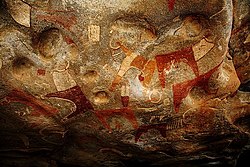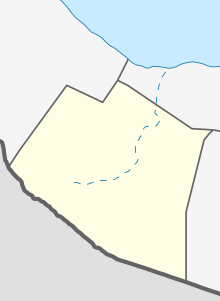| Laas Geel | |
|---|---|
 Long-horned cattle and other rock art in the cave complex. Long-horned cattle and other rock art in the cave complex. | |
  | |
| Location | Hargeisa, Marodi Jeh, Somaliland |
| Coordinates | 9°46′51.28″N 44°26′37.11″E / 9.7809111°N 44.4436417°E / 9.7809111; 44.4436417 |
| Discovery | 2002 |
| Access | Public |
Laas Geel (Somali: Laas Geel), also spelled Laas Gaal, are cave formations on the rural outskirts of Hargeisa, Somaliland, situated in the Maroodi Jeex region of the country. They contain some of the earliest known cave paintings of domesticated African aurochs (Bos primigenius africanus) in the Horn of Africa. Laas Geel's rock art is estimated to date to circa 3,500-2,500 BCE.
Discovery

During November and December 2002, an archaeological survey was carried out in Somaliland by a French team of researchers. The expedition's objective was to search for rock shelters and caves that contained archaeological sediments and infills in order to document the historical period when production economy appeared in this part of the Horn of Africa (circa 5,000 to 2,000 years BCE). During the course of the survey, the excavation team discovered the Laas Geel cave paintings, that encompass an area of ten rock alcoves (caves). In an excellent state of preservation, the rock art depicts wild animals and decorated cattle (cows and bulls). They also feature herders, who are believed to be the creators of the paintings. Laas Geel's rock art is executed in the same distinctive Ethiopian-Arabian style as the Dhambalin and Karinhegane cave paintings that are also situated in Somaliland.
Although the Laas Geel rock art had been known to the area's inhabitants for centuries, its existence only came to international attention after the 2002 discovery. In November 2003, a mission returned to Laas Geel and a team of experts undertook a detailed study of the paintings in their prehistoric context.
Somaliland in general, is home to numerous such archaeological sites and megalithic structures, with similar rock art found at Haadh, Gudmo Biyo Cas, Dhambalin, Dhagah Maroodi and numerous other sites, while ancient edifices are, among others, found at Sheikh, Aynabo, Aw-Barkhadle, Ancient Amud, Heis, Maydh, Haylan, Qa’ableh, Qombo'ul and El Ayo. However, many of these old structures have yet to be properly explored, a process which would help shed further light on local history and facilitate their preservation for posterity.

Description
The Laas Geel cave paintings are thought to be some of the most vivid rock art in Africa. Among other things, they depict cattle in ceremonial robes accompanied by humans, who are believed to have been inhabitants of the region. The necks of the cattle are embellished with a kind of plastron. Some of the cattle are also portrayed wearing decorative robes. Besides long-horned cattle, the rock art also shows an image of a domesticated dog, several paintings of Canidae as well as a giraffe. The site is excellently preserved due to the location of the paintings which are covered by the granite overhangs.
Demographics
Laas Geel is primarily inhabited by people from the Somali ethnic group, with the clan eponyms of Adam Isa and Abokor Isa of Isamusa especially well-represented.
Gallery
-
 Depiction of a ceremonial cow
Depiction of a ceremonial cow
-
 A human and cow
A human and cow
-
 A herd of cows
A herd of cows
-
 A single cow
A single cow
-
 One of the alcoves at Laas Geel
One of the alcoves at Laas Geel
-
 Various rock art
Various rock art
-
Various other rock art
-
 A camel
A camel
The word laas geel consist of two words according to Somali languages which is laas and geel, the word laas means well and the word geel means camel in Somali. Well refers to a source of water which camels and other livestock drink from as well as the people.
See also
References
- "Laas Geel, Somaliland". British Museum.
Unlike many other rock art sites, Laas Geel has been dated quite precisely thanks to the excavations carried out in one of the shelters by the French team that documented the site. During the excavation parts of the painted rock wall were recovered, and therefore the archaeologists have proposed a chronology of mid-4th to mid-3rd millennia, being one of the oldest evidences of cattle domestication in the Horn of Africa and the oldest known rock art site in this region.
- Farrar, V. Tarikhu (2020-01-31). Precolonial African Material Culture: Combatting Stereotypes of Technological Backwardness. Rowman & Littlefield. ISBN 978-1-7936-0643-3.
- Bradley, D G; MacHugh, D E; Cunningham, P; Loftus, R T (1996-05-14). "Mitochondrial diversity and the origins of African and European cattle". Proceedings of the National Academy of Sciences of the United States of America. 93 (10): 5131–5135. Bibcode:1996PNAS...93.5131B. doi:10.1073/pnas.93.10.5131. ISSN 0027-8424. PMC 39419. PMID 8643540.
- Pitt, Daniel; Sevane, Natalia; Nicolazzi, Ezequiel L.; MacHugh, David E.; Park, Stephen D. E.; Colli, Licia; Martinez, Rodrigo; Bruford, Michael W.; Orozco‐terWengel, Pablo (2018-07-23). "Domestication of cattle: Two or three events?". Evolutionary Applications. 12 (1): 123–136. doi:10.1111/eva.12674. ISSN 1752-4571. PMC 6304694. PMID 30622640.
- Mwai, Okeyo; Hanotte, Olivier; Kwon, Young-Jun; Cho, Seoae (July 2015). "African Indigenous Cattle: Unique Genetic Resources in a Rapidly Changing World". Asian-Australasian Journal of Animal Sciences. 28 (7): 911–921. doi:10.5713/ajas.15.0002R. ISSN 1011-2367. PMC 4478499. PMID 26104394.
- Brass, Michael (2018-03-01). "Early North African Cattle Domestication and Its Ecological Setting: A Reassessment". Journal of World Prehistory. 31 (1): 81–115. doi:10.1007/s10963-017-9112-9. ISSN 1573-7802.
- ^ The Journal of African Archeology Volume 1.2 (2003) Chapter 3
- Bakano, Otto (April 24, 2011). "Grotto galleries show early Somali life". AFP. Archived from the original on 30 April 2011. Retrieved 11 May 2013.
- Istituto universitario orientale (Naples, Italy) (1992). Annali: Supplemento, Issues 70-73. Istituto orientale di Napoli. p. 57.
- Mire, Sada (2015-04-14). "Mapping the Archaeology of Somalia: Religion, Art, Script, Time, Urbanism, Trade and Empire". African Archaeological Review. 32 (1): 111–136. doi:10.1007/s10437-015-9184-9. ISSN 0263-0338.
- Michael Hodd, East African Handbook, (Trade & Travel Publications: 1994), p.640.
- "Photographs of Laas Geel, February 2015". Independent Travellers. independent-travellers.com. Retrieved July 15, 2017.